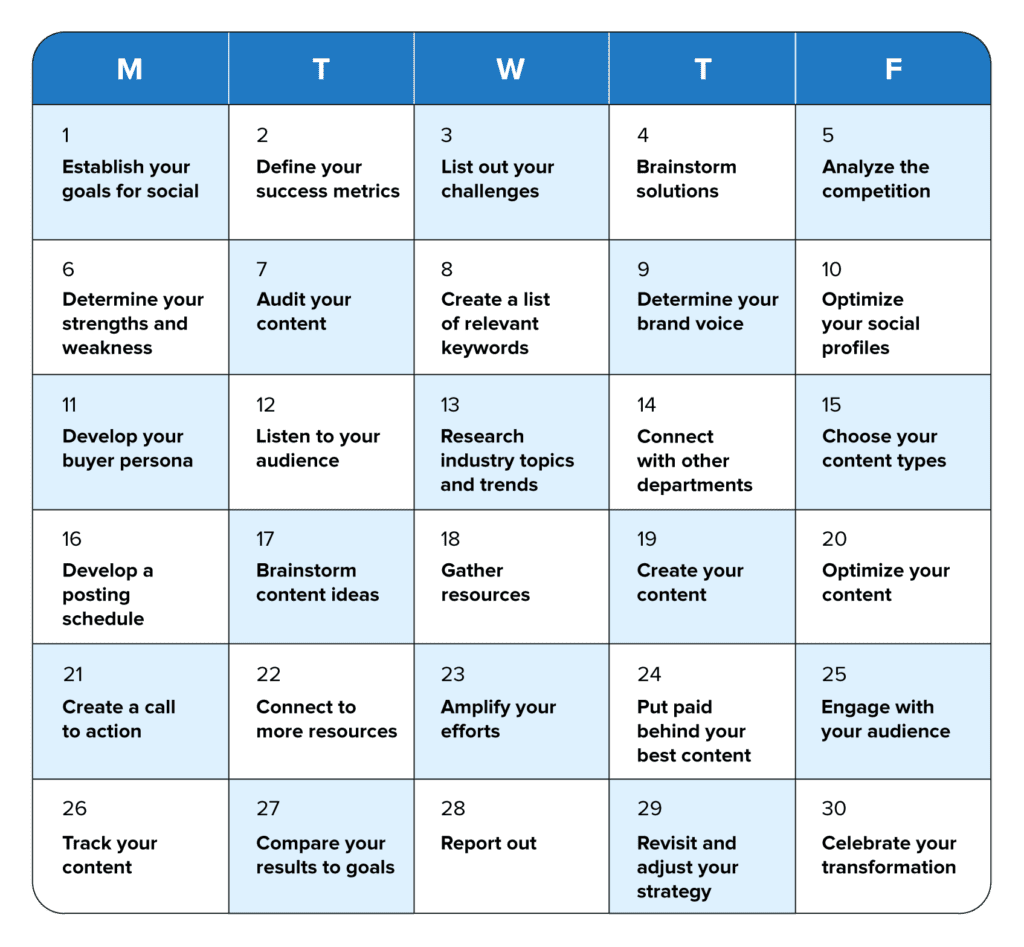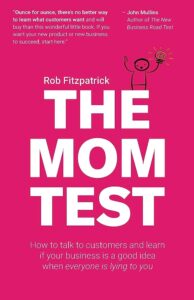The Ultimate 9-Step Process To Launching A New Project on Social Media
Launching a product on social media is a great chance to gain more followers, make sales, and turn your current audience into customers.
Unlike a typical in-store promotion, social media allows brands to reach thousands of potential customers when they release something new.
But it’s not as simple as posting one thing on the day of the launch. A successful product launch needs careful planning.
If you’ve been thinking about how to launch a product on social media for a while now, you’re in luck. In this guide, we’ll explain everything you need to launch a new product on social media, from setting your goals and creating a strong idea to making a content plan that excites people and leads to sales.
If you’re more of a watcher than a reader, check out this video by Chase Curtis about how to build hype for your new product – it’s a great addition to this article!
The 9-Step Social Media Launch Process
Launching a product on social media demands a strategic approach to stand out in the digital crowd.
Our 9-step social media launch plan provides a systematic blueprint for orchestrating a successful product launch campaign.
Each step is meticulously designed to help you navigate the complexities of planning, executing, and measuring the impact of your launch on various social media platforms. From setting clear goals to harnessing influencer marketing, this comprehensive guide empowers you to master the art of product launches in the digital age.
So, let’s get going!
Step 1: Set Your Goals

Begin your social media campaign by clearly defining your objectives and key performance indicators (KPIs).
Identify what success means for your brand, whether it’s increasing brand awareness, improving perception, boosting sign-ups and sales, or a combination. Having well-defined goals allows you to create effective strategies.
Goals should create clear and effective objectives that you can measure your success by. Your goals should be:
- Specific – i.e. how many people will you reach in your campaign, how long will your campaign last for?
- Measurable – give some numbers so you can measure success
- Achievable – by all means reach for the stars, but make sure you’ve got a chance of getting there
- Relevant – are these goals going to help your business launch successfully?
- Time-bound – how long do you have to achieve your goals?
For example, the goals for your social media product launch could be:
- Reach 20k women in their 30s within the first 3 weeks of launch
- Convert 1,500 people to our product in 2 months
Step 2: Set a Timeline
Timing is crucial for a successful product launch on social media.
Start by setting your launch date as a deadline and work backwards to plan your timeline. Consider lead time for tasks like photoshoots, influencer collaborations, and content production.
Break your campaign into phases, such as pre-launch hype, launch day, post-launch follow-up, and integration into regular content.
Step 3: Identify Which Social Media Channels Are Best
Focus your efforts on social media platforms that align with your product launch goals.
Each platform requires a unique content strategy. For instance, TikTok may be ideal for reaching a younger audience, while Instagram offers integrated e-commerce features.
Quality over quantity matters; prioritize platforms where you can excel and where your target market hang out. If you’ve not identified your target market yet, check out our complete guide to doing so here.
Step 4: Get Creative

Craft a compelling visual style and campaign message to set the tone for your product launch.
Define a color palette, gather inspirational imagery, and create design guidelines. Ensure your campaign message is consistent across all content. This step is essential for visually tying your campaign together.
Check out these great creative examples by Appnova if you’re looking for inspiration.
Step 5: Create Your Assets
Generate photos, videos, graphics, and GIFs that align with your campaign’s creative direction.
Tailor your content to the type of product (physical or digital) and company size. Ensure high-quality content, stick to your design brief, include your branded hashtag, and consider content repurposing for various platforms.
We’d recommend getting most of your assets ready in advance of your launch so there’ll be no manic rush to get content prepared during your launch – you’ll have plenty of other things to be getting on with!
Step 6: Influencer Marketing Strategy
Leverage influencer marketing to amplify your product launch’s impact.
Choose influencers based on your product, budget, and objectives. Consider partnering with Nano or Micro-influencers for higher engagement and lower costs.
Determine the content format that best suits your goals, whether it’s YouTube demos, Reels tutorials, or Instagram Stories.
You can learn more about how to create the ultimate marketing strategy for your business here.
Step 7: Create a Content Calendar
Plan your social media content calendar for maximum engagement and reach.
While your product’s official launch day may differ from your social media schedule, early teasers can build anticipation. Use a digital content calendar to schedule posts across platforms, and maintain a cohesive grid aesthetic.
Click here to learn more about how to do this.
Step 8: Launch Your Product on Social Media
On launch day, have your content and captions ready. Monitor audience engagement, answer questions, and engage with your community.
Use countdowns, bio updates, Instagram Highlights, and Live sessions to maintain excitement. Encourage user-generated content and participation in the launch.
Step 9: Track Your Success
Evaluate your campaign’s success against the goals and KPIs you created in Step 1.
Analyze content performance, format effectiveness, and engagement on various platforms. You can then use these insights to improve your future campaigns and update your campaign on the fly to better target your audience and improve your social media product launch.
Additional Tips and Tricks For Your Social Media Launch
In addition to our social media launch strategy, here are 3 extra tips to help your product launch be a success.
Create Your Own Brand Hashtags
Creating a catchy hashtag has both online and offline benefits.
- Online, it sets your product apart, sparks conversations, and helps users find information.
- Offline, it works during launch events, motivating attendees to share their experiences online, extending the event’s reach.
An example is Oreo’s #OreoHorrorStories hashtag for a Halloween campaign, boosting engagement and sales by linking cookies to popular horror movies using Vine, a successful strategy.
Engage With Your Target Audience
To generate excitement, make sure your social media content is valuable and shareable.
Each tweet or Facebook post should provide a reason for engagement and keep people interested enough to consider buying your product. Once you’ve captured their interest, emphasize how your product fulfills their needs before they make a purchase.
Don’t Just Use Text
Videos are more impactful than text because they include visuals. While making videos takes effort, it’s worth it. Videos can serve as mini-ads, show behind-the-scenes action, feature stop-motion animation, or explain your products.
These videos keep users engaged even after the product launch. No matter the type, videos can excite your audience.
Social Media Launch Announcement Examples
Sometimes it can be difficult to find the right words to say. That’s why we’ve come up with 3 awesome social media announcement examples for you to use on your launch.
I’ve got something awesome in the works, and I’m sure you’ll be thrilled!
If you want to be the very first to hear about it, hop on the early bird waitlist right here: [LINK]
[PRODUCT NAME] was born out of a strong “why,” and it’s almost ready to meet the world!
Don’t miss out – sign up to stay in the loop for when it’s officially available: [LINK]
Exciting news! In just a few days, I’m launching [PRODUCT NAME].
Jump on the waitlist now to snag early bird [pricing/bonuses]: [LINK]
Social Media Launch Plan Template
As we mentioned earlier, it’s really important to have a social media launch plan to keep you on track. That’s why we’ve included this social media launch plan template to help you get started, courtesy of Sprout Social.

Key Takeaways
- Launching a product on social media offers opportunities to gain followers, boost sales, and convert your audience into customers.
- Unlike traditional promotions, social media enables brands to reach a wide audience when introducing a new product.
- Successful product launches require careful planning, including setting clear goals and creating valuable content.
- The 9-step social media launch process offers a systematic blueprint for a successful social media launch campaign, from goal-setting to influencer marketing.
- Key steps in the process include defining goals, setting a timeline, choosing the right social media channels, creating compelling content, and tracking success.
- Leveraging influencer marketing, creating a content calendar, and using branded hashtags can enhance your product launch strategy.
- Engaging with your target audience and incorporating visuals like videos can boost the effectiveness of your social media product launch.
FAQs
How Do I Launch a New Product on Social Media?
Launching a new product on social media requires a well-thought-out strategy to capture the attention of your target audience and drive engagement. Here’s a step-by-step approach:
- Define Your Goals: Start by clearly outlining your objectives. Are you aiming to increase brand awareness, drive sales, or boost user engagement? Having specific goals will guide your entire launch strategy.
- Know Your Audience: Understand your target audience’s preferences, behaviors, and pain points. Tailor your messaging and content to resonate with their needs and interests. Create buyer personas to help you identify the most effective channels for reaching them.
- Choose the Right Social Media Platforms: Not all social media platforms are created equal. Select the ones that align with your product and audience. For visual products, Instagram and Pinterest might be ideal, while B2B products may benefit from LinkedIn. Ensure your profiles are optimized with relevant keywords, and consider running paid ads on these platforms to expand your reach.
- Create Compelling Content: Develop eye-catching visuals and engaging copy that showcases your product’s unique features and benefits. Use storytelling to connect with your audience emotionally. Tease the launch with sneak peeks and countdowns to build anticipation.
- Leverage User-Generated Content: Encourage your existing customers to create and share content related to your new product. User-generated content (UGC) not only serves as authentic social proof but also extends your product’s reach to their networks.
- Engage with Your Audience: Interact with your followers by responding to comments, messages, and feedback promptly. Host live Q&A sessions to address queries and generate buzz. Regularly post updates to keep the momentum going even after the initial launch.
- Measure and Adjust: Use social media analytics tools to track the performance of your product launch. Monitor key metrics such as engagement, website traffic, conversion rates, and sales. Based on the data, adjust your strategy to optimize results and continually refine your approach.
By following these steps, you can successfully launch your new product on social media, creating a buzz and driving meaningful engagement with your target audience.
How Do I Launch a New Product on Social Media in a New Market?
Reaching people on social media to launch a new product in a new market can be a challenging but rewarding endeavor. Here’s a step-by-step guide:
- Market Research and Targeting:
- Begin by conducting thorough market research to understand the dynamics, preferences, and behaviors of your target audience in the new market.
- Create detailed buyer personas to identify who your ideal customers are, what platforms they use, and what content resonates with them.
- Localize Your Strategy:
- Tailor your messaging, content, and even product features to suit the local market’s cultural nuances and preferences.
- Collaborate with local influencers or experts who can authentically endorse your product.
- Choose the Right Social Media Platforms:
- Based on your target audience’s preferences, select the most relevant social media platforms. In some markets, Facebook or Instagram might dominate, while others may favor platforms like WeChat or TikTok.
- Set up or optimize your profiles on these platforms with localized content.
- Content Strategy:
- Develop a content strategy that speaks directly to the needs and interests of your new market’s audience.
- Create engaging and culturally sensitive content that showcases how your product addresses their pain points.
- Paid Advertising:
- Invest in paid advertising campaigns on social media to expand your reach quickly. Use targeted ads to reach your desired audience.
- Experiment with different ad formats and messaging to identify what resonates best with the new market.
- Leverage User-Generated Content (UGC):
- Encourage your new customers to create UGC related to your product. User-generated content adds authenticity and builds trust.
- Share this UGC on your social media profiles to showcase real experiences with your product.
- Engagement and Community Building:
- Actively engage with your audience by responding to comments, messages, and reviews in a timely and personal manner.
- Create and nurture a community around your brand by hosting live Q&A sessions, contests, and discussions.
- Localized Influencer Partnerships:
- Collaborate with local influencers who have a significant following in your target market. These influencers can help you reach a broader audience and build credibility.
- Measure and Adapt:
- Continuously monitor the performance of your social media campaigns using analytics tools. Track key metrics like engagement, conversion rates, and sales.
- Based on the data, make data-driven adjustments to your strategy, such as refining ad targeting or optimizing content.
How Do I Advertise My New Product on Social Media?
Here are the simple steps for advertising your product:
- Plan ahead.
- Pick the best social media platforms.
- Know your audience.
- Include your website link and unique hashtags.
- Promote on other social sites.
- Consider Reddit ads.
- Use Facebook ads.
- Set up a Facebook and Instagram Shop.
- Tag products in your posts.
- Partner with influencers.
- Utilize digital marketing tools.
- Seek press coverage.
- Monitor and improve performance.
How Do I Build Hype for a Product Launch on Social Media?
Here’s our 8-step process to building hype for your social media product launch:
- Show Behind-the-Scenes:
- Share videos of how your product is made or your team at work. Post them on Instagram or Facebook Live to get people excited about your product launch.
- Create Mystery:
- Keep your product a bit of a secret to spark curiosity. This gets people talking and eager to find out more.
- Use Social Media Ads:
- Advertise your product on Facebook or LinkedIn. Ask people to sign up for updates or trials. This helps you reach more people and keeps them interested.
- Team Up with Influencers:
- Partner with social media stars who match your brand. They’ll help promote your product and boost sales.
- Hold Contests and Giveaways:
- Organize fun contests on social media to get more people interested in your product. Encourage them to share with friends.
- Make Informative Videos:
- Create videos that show how great your product is. Share them to inform and entertain your audience.
- Offer Pre-Orders:
- Let loyal customers order your product before it’s out. This creates buzz and word-of-mouth excitement.
- Plan Social Posts:
- Work with your product team to plan when and what to post on social media. Share the best parts of your product with your audience.
How Do I Do a Successful Social Media Launch For a Book?
Launching a book on social media can be a powerful way to generate buzz and reach your target audience. Here’s 9 steps to executing a successful social media book launch:
- Pre-launch Buildup:
- Set Clear Goals: Determine what you want to achieve with your book launch, such as increasing sales, gaining more followers, or getting reviews.
- Identify Your Audience: Know your target readers and their preferred social media platforms.
- Create a Content Calendar: Plan your posts leading up to the launch date. Include teasers, author insights, and engaging content.
- Leverage Email Lists: If you have an email list, use it to inform subscribers about the upcoming launch.
- Engaging Content:
- Teasers: Share teasers from the book, such as quotes, excerpts, or intriguing questions.
- Behind-the-Scenes: Give your audience a sneak peek into your writing process or the story’s background.
- Author Q&A: Host live Q&A sessions where readers can interact with you.
- Video Content: Create short videos discussing the book’s themes, characters, or your writing journey.
- Leverage Social Media Platforms:
- Choose the Right Platforms: Focus on platforms where your target audience is most active. For many book launches, this includes Instagram, Twitter, Facebook, and Goodreads.
- Use Hashtags: Research and use relevant book-related hashtags to increase your posts’ discoverability.
- Collaborate: Partner with book bloggers, influencers, or authors in your genre for shoutouts, reviews, or joint events.
- Run Contests and Giveaways: Encourage user-generated content and excitement by running book-related contests or giveaways.
- Create a Dedicated Book Landing Page:
- Author Website: If you have one, create a dedicated page for your book.
- Book Cover and Synopsis: Display the book cover and a compelling synopsis.
- Pre-order and Purchase Links: Include links for pre-orders or direct purchases.
- Reviews and Testimonials: If available, feature early reviews or endorsements.
- Newsletter Signup: Allow visitors to sign up for updates.
- Engage with Your Audience:
- Respond Promptly: Reply to comments, messages, and reviews to build a community.
- Thank Your Supporters: Express gratitude to readers, bloggers, and influencers who support your book.
- Launch Event:
- Live Launch: Host a virtual launch event on platforms like Facebook Live or Instagram Live. Share the moment with your audience.
- Post-launch Promotion:
- Maintain Momentum: Continue to engage with your audience after the launch. Share reader reviews, host discussions, and keep the conversation going.
- Promote Reviews: Share positive reviews and encourage readers to leave reviews on platforms like Amazon and Goodreads.
- Utilize Paid Advertising: Consider running targeted social media ads to reach a broader audience.
- Measure and Adjust:
- Analytics: Use platform analytics and book sales data to measure your campaign’s success.
- Feedback: Gather feedback from readers and adjust your approach for future launches.
- Book Blog Tours: Collaborate with book bloggers who can feature your book through reviews, author interviews, or guest posts.
Overview
Follow these steps for a comprehensive guide to a successful product launch on social media.
If you’re not just looking to launch your product on social media, check out our complete guide to launching your product, as well as our research on the 40 best places to launch your business and the 5 creative marketing strategies you need to help your business succeed.







